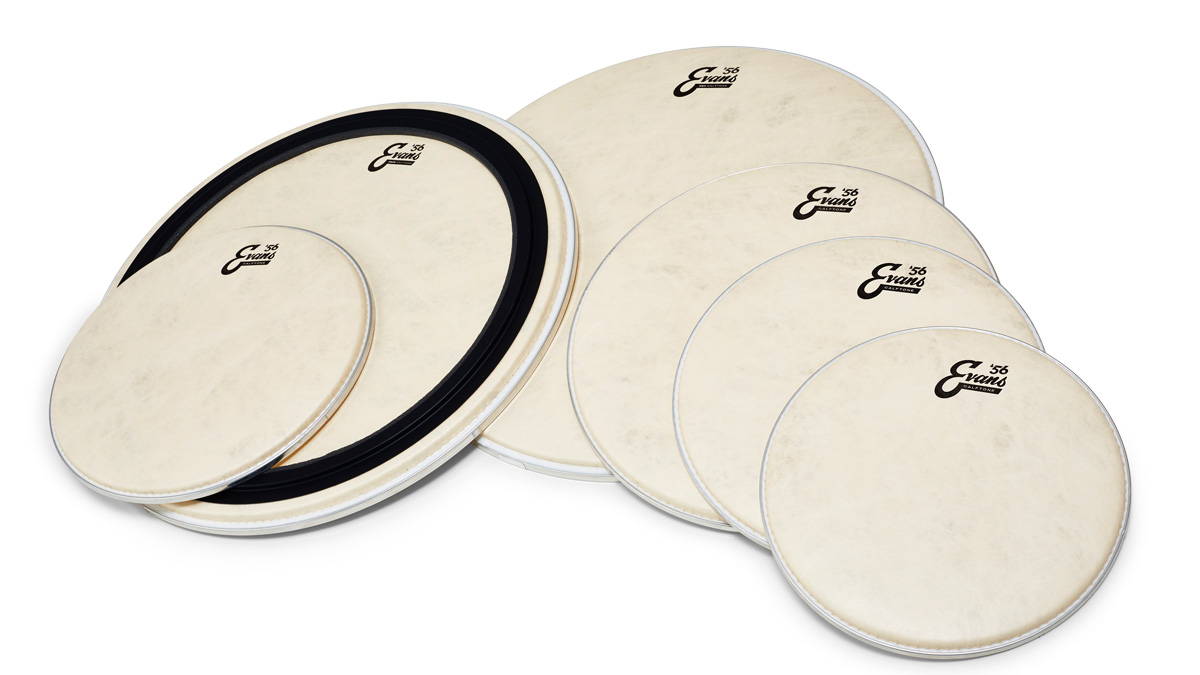MusicRadar Verdict
With Calftones you enter a different sonic world, one with many fans in today's music which encompasses world-jazz-folk-acoustic elements.
Pros
- +
Lush vintage heads.
Cons
- -
Very few.
MusicRadar's got your back
It's 60 years since Evans was founded and in recognition of this the company has launched its '56 series of Calftone heads, designed to mimic the sound and feel of the skins Chick Evans' plastic revolution replaced.
Real calf skins were/are inconsistent, subject to organic variations, but many drummers would still like to recapture the sound.
Build
These are cool-looking heads with their classic 1950s-style logo, and as ever with Evans there is the air of quality about the construction. The underside reveals the shiny clear Mylar that provides the base, while the top is a creamy, fibrous parchment that looks similar to Remo's longstanding Fibreskyns.
Calftone toms and snares have a 7-mil Mylar base where Remo's Ambassador Fibreskyns are 10-mil, so the Calftones are more akin to Remo's (7.5-mil) Diplomat Fibreskyns.
There is at present just the one standard Calftone for toms and snares (ranging from 6" to 18"). There are though three bass drum alternatives: standard, EMAD and EQ4, in 16" to 26" sizes. Calftones also benefit from the Evans Level 360 construction which aims to make seating and tuning easier.
Hands On
Calftone toms and snares have a 7-mil Mylar base where Remo's Ambassador Fibreskyns are 10-mil, so the Calftones are more akin to Remo's (7.5-mil) Diplomat Fibreskyns.
As such they are lighter and more resonant and toms tune up readily to vintage bebop levels, supplying a classic Max Roach jazzy, concise tone. Tuning the smaller toms medium-high there is a good ping with a thicker, more complex timbre than from the usual modern single-ply head. Damping is unnecessary.
They also work tuned lower for a more throaty rumble, particularly on floor toms. Go too low and they rattle, but the tone remains plump with minimal overtones, which makes tuning easy and drums studio/mic ready.
Bass drum heads have a 12-mil Mylar base; the EQ4 has a 10-mil perimeter control ring while the EMAD has its interchangeable system of foam damping rings in the plastic perimeter tray. They both, and particularly the EMAD, focus the darker, thumpier, edgier frequencies of the heads. Is this at odds with the Calftone goal? Well, it's 2016, not 1956, and some drummers will want the earthy calf tone but also a click-ier, rock-ier bite.
Fitting the 22" EQ4 to our 1965 Ludwig was fabulous - a hard-ish punch capping a full-bodied richness, not as slappy as modern heads, more a vintage Mitch Mitchell 'bonk'. A keeper. The standard 22" '56 was similar and even warmer, lots of mid-range presence, when accompanied by an old-school felt strip damper.
Slapping the 14" on a wood shell snare was equally gratifying. There's that parchment-like crispness, a taut, versatile, sonorous and luxurious feel, the snares always crunchy. Oh, and absolutely perfect for brushes.
With its latest free update, Ableton has finally turned Note into the app I always wanted it to be
Technically capable, but struggle to make your tunes sound musical? 5 simple music theory hacks to make your tracks stand out
"Despite its size, it delivers impressive audio quality and premium functions as well as featuring a good selection of inspired sounds": Roland GO:Piano 88PX review










